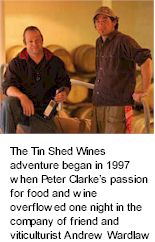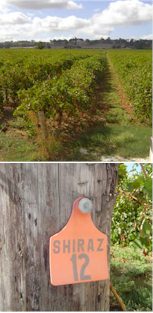


The Tin Shed Wines adventure began in 1997 when Peter Clarke’s passion for food and wine overflowed one night in the company of friend and viticulturist Andrew Wardlaw. Peter is head chef and part-owner of the award-winning Vintners Bar & Grill near Angaston.

The following year, the pair combined their talents in a small tin shed to create their first wine. This Shiraz was mollycoddled from the outset – handpicked and hand nurtured using wild fermentation and minimal additions. The undivided attention the fruit and resulting wine received paid off, with the Single Wire Shiraz receiving accolades from wine lovers and wine writers alike.
Despite the temptation to accelerate production, Tin Shed Wines chose instead to concentrate on creating wines that were subtle and allowed the real character of the vineyard to dominate. Rather than produce larger volumes of one particular wine, Peter and Andrew pooled their expertise and played with a new blend of Mourvedre, Shiraz and Grenache.
The success of this second wine led to other inspired decisions, such as the Wild Bunch Riesling in 2002, again a result of the same techniques – wild ferment, minimal additions and loads of attention. Following this the Melting Pot Shiraz, then one particular “fruit salad” block, inspired the production of the All Day Rosé.

Tin Shed Wines now boasts five labels. Each of them demands an equal amount of nurturing, so total production is still limited to 5000 cases each year. These wines were designed to be unique and are continually being hailed as such by those who have the privilege of tasting them.
In 2006, Peter and wife Anne, took sole ownership of Tin Shed Wines. Enter viticulturist/winemaker Nathan Norman, who was attracted to the winery because of its attention to detail. The Tin Shed dream has not faltered over the years. The small team is still intent on mollycoddling its wines, to produce real vineyard flavours that complement food without overpowering it.
"From a relatively small boutique operation, these intriguing wines were tasted from barrel. The 2004 Three Vines, a blend of old vine Mourvèdre, Syrah and Grenache, exhibits a dense ruby/purple colour along with a big nose of tree bark, fresh mushrooms, blueberries, raspberries, Provençal herbs, and garrigue. A complex, 300- liter hoshead-aged, French-styled red, it should drink well for 3-4 years. A stunning offering, the 2005 Melting Pot Shiraz reveals flamboyant aromas of cassis, black pepper, licorice and espresso roast. This medium to full-bodied, pure, rich Shiraz offers another example of the seamlessness of this vintage.
"The 2005 Single Wire Shiraz is dense, opulent and even richer than the Melting Pot with intense flavors, a natural full-bodied texture, and a 40+-second finish. It should drink well for 10-12 years. Lastly, the 2004 Single Wire Shiraz (also tasted from barrel) is certainly outstanding, but it plays second fiddle to its 2005 sibling!" -Robert Parker

























